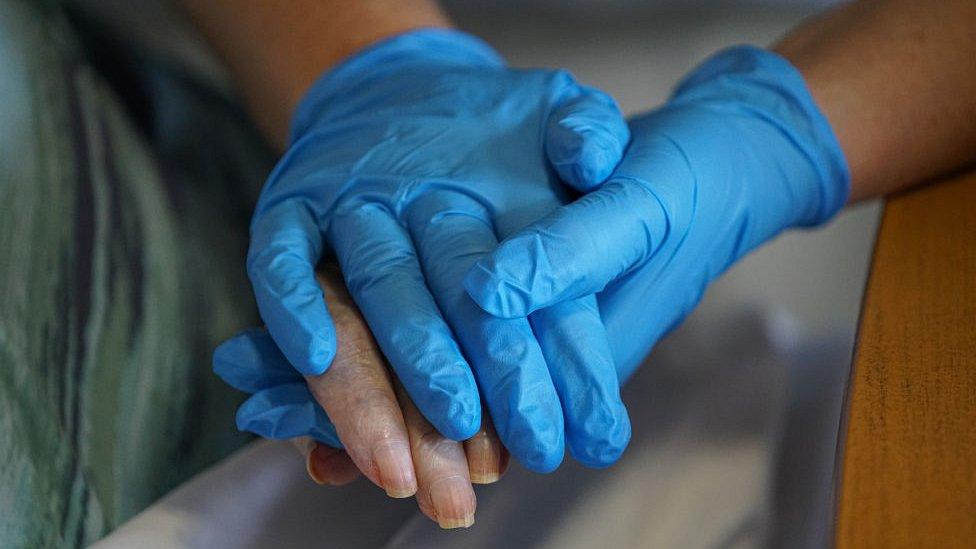Covid: Greater Manchester stops care home tests over accuracy fears
- Published
- comments

Greater Manchester councils have become the latest to pause rapid testing for care home visitors over concerns they fail to detect enough infections.
Data suggests the rapid kits miss about a third of the most infectious cases picked up by conventional lab tests.
Lateral flow tests are being used in England so residents can see family indoors for the first time since March.
The government has described rapid testing as way of reducing, rather than eliminating, risk.
The rapid lateral flow tests work by taking a nose and throat swab, shaking it in fluid until any viral particles come off, and then dropping the fluid onto a plastic stick - a bit like a pregnancy test.
They take about half an hour to show a result - one line on the paper strip means the test has worked and two lines means virus is present.
Their speed, and the fact they don't need to be taken to a lab, mean these tests - in theory - can be used to make on-the-spot decisions such as deciding if someone can go into premises like a care home or event venue.
Manchester's decision follows similar assessments elsewhere.
Sheffield has paused lateral flow tests for care home visits which it considers how best to use them.
In Liverpool, visitors are permitted inside but they have to take multiple tests.
Similar solutions are being considered around Greater Manchester.
How accurate are they?
A standard coronavirus test - also known as a PCR test - misses fewer than 5% of infections.
It was already known that lateral flow tests were less sensitive - they miss about 50% of infections overall.
But lab tests had suggested that figure could fall to 5% when a high level of virus was present.
The government had argued that the tests were therefore as effective as PCR tests at picking up people with the most virus in their systems - those most likely to be currently infectious.
However, data published from the Liverpool testing pilot suggests that when it comes to people with higher viral loads, rapid tests only pick up seven infections for every 10 picked up by a PCR test.
This means about a third of the most potentially infectious people could be told they were free of the virus. This could be even lower if the tests were conducted by non-clinically trained people.
How much of a problem is this?
There are different uses for rapid tests.
When mass testing was piloted in Liverpool, about 1,000 coronavirus cases were picked up in people without symptoms who would not otherwise have been tested.
Even if the rapid tests only pick up half of cases, those are all extra cases that wouldn't have been found and so, in a sense, are all a win.
There is some concern that people may change their behaviour as a result of a negative test, perhaps stopping social distancing. It's not yet know how big a problem that might be.
The main aim of that type of testing is to act on positive results, asking those detected to quarantine, but also telling people with a negative result to continue to keep to the guidance as normal.
According to Prof Jon Deeks at the University of Birmingham, the bigger problem is when rapid tests are used to make decisions based on a negative result.
That includes care home visits, or university students who feel free to mingle with other households based on a negative test.
"There is a difference [between] mass testing to 'break chains of transmission', where any true positive result is a gain - in that case it doesn't matter too much that you miss some people - and testing to 'be safe', where the focus is on whether the negative result is trustworthy," he explained.
Those potentially false negative results could be used to make a dangerous decision - for example, relatives may then hug a loved one in a care home who is at high risk, potentially infecting them and other vulnerable residents.
A Greater Manchester spokesperson said: "We're committed to facilitating care home visiting, we know how important it is to relatives and residents who have waited so long for this, but we also want to ensure we get this right and do it as safely as possible.
"We now have the government guidance, as well as the recommendations from our own testing expert group, and our directors of public health, adult social care leads and care homes are all working together to get things in place as fast as we can."
Dr Angela Raffle at the University of Bristol, who has also worked for the UK National Screening Programmes, said people with expertise in whole-population testing hadn't had input into the government's plans.
Screening healthy populations can cause harm, for example "people who test negative may be falsely reassured and you could actually increase transmission", she told the BBC.
Are they still useful?
Like so many things in the pandemic, this is about balancing risks and benefits.
For some care home residents, a lack of visits has caused great distress and according to some families, a worsening of their health.
No test is 100% effective, and lateral flow tests are considerably less than that.
Some councils are trialling different ways of using them, for example asking visitors to take a PCR test a week before the visit and a rapid test on the day.
Dr Susan Hopkins, senior medical adviser to Public Health England and NHS Test and Trace, described the tests as an "additional tool in helping us detect Covid-19 cases that we wouldn't otherwise know about". That, she said, would help break chains of transmission and save lives.
She added they should be used "in combination with other vital infection prevention control measures such as wearing appropriate PPE, washing hands regularly and social distancing".